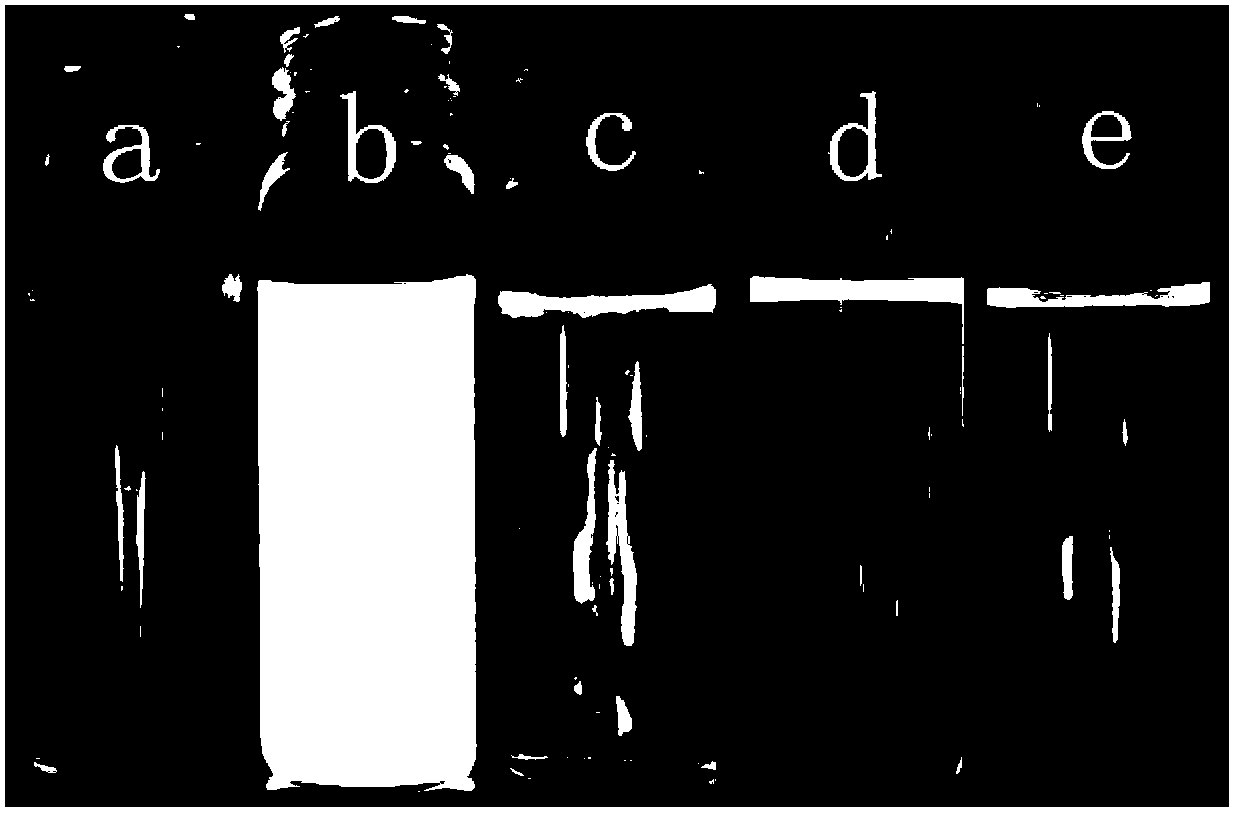Preparation method and application of supermolecule composite nano particles
A technology of supramolecular composites and nanoparticles, applied in the field of organic light-emitting materials, can solve problems such as poor processing performance, achieve the effects of easy processing, simple preparation methods, and reduced non-radiative transitions
- Summary
- Abstract
- Description
- Claims
- Application Information
AI Technical Summary
Problems solved by technology
Method used
Image
Examples
Embodiment 1
[0103] A preparation method of supramolecular composite nanoparticles, comprising the following steps:
[0104] 1) Dissolve G4 PAMAM dendrimers and TPE-4-COOH in methanol respectively, and prepare them at a concentration of 1×10 -4 M and 1×10 -3 M solution;
[0105] 2) Dissolve TPE-4-COOH (50 μL) and different volumes of G4 PAMAM dendrimers in 10 ml of methanol, keeping the concentration of TPE-4-COOH at 5×10 -6 M, amino / carboxyl molar ratios are: 0, 0.05, 0.1, 0.2, 0.3, 0.4, 0.5, 1.0, 1.5, 2, 4, 6, 8, 10, 12, 14, 15, 16, 17, 18, 20, 24;
[0106] 3) Ultrasonic for 1 hour, after standing still, methanol solutions of supramolecular complex nanoparticles were obtained respectively, and their fluorescence emission spectra were tested.
[0107] Figure 7 It is the fluorescence intensity figure (excitation wavelength is 350nm) of the methanol solution of the supramolecular composite nanoparticle adopting different amino / carboxyl molar ratios of embodiment 1 at 462nm, and the up...
Embodiment 2
[0112] A preparation method of supramolecular composite nanoparticles, comprising the following steps:
[0113] Same as Example 1, the difference is that in step 2), the concentration of the amino functional group is kept at 3.2×10 -4 M, while controlling the concentration of carboxyl groups at 1×10 -6 M~1×10 -4 M, carboxyl / amino molar ratios are 0.06, 0.31, 0.63, 1, 1.25, 1.56, 1.88, 2.19, ultrasonic for 0.5 hours, methanol solutions of supramolecular composite nanoparticles with different composition ratios can be obtained.
[0114] Figure 11 It is the change diagram of the fluorescence intensity at 462nm of the methanol solution of supramolecular composite nanoparticles with different carboxyl / amino molar ratios in Example 2 (excitation wavelength is 350nm). When the carboxyl / amino group molar ratio is 1, the fluorescence enhancement of the obtained supramolecular composite nanoparticles is the largest.
[0115] Figure 12 It is the SEM picture of the supramolecular c...
Embodiment 3
[0118] A preparation method of supramolecular composite nanoparticles, comprising the following steps:
[0119] 1) Dissolve G10, G7, G4, G1 PAMAM dendritic polymers and TPE-4-COOH in ethanol, respectively, and prepare them at a concentration of 1×10 -5 M and 1×10 -3 M solution;
[0120] 2) Dissolve TPE-4-COOH (50 μL) and different volumes of G10, G7, G4, G1 PAMAM dendrimers in 10 ml of ethanol, keeping the concentration of TPE-4-COOH at 1×10 -5 M, the amino / carboxyl ratio is 1;
[0121] 3) Sonicate for 2 hours and let stand to obtain a stable ethanol solution of supramolecular complex nanoparticles emitting blue fluorescence.
[0122] Figure 14 It is the fluorescence emission spectrogram (excitation wavelength is 350nm) of the supramolecular complex nanoparticle ethanol solution of embodiment 3. Compared with the TPE-4-COOH solution, the fluorescence intensity at 462nm of the supramolecular complex nanoparticles formed by G10, G7, G4, and G1 PAMAM dendrimers and TPE-4-CO...
PUM
 Login to View More
Login to View More Abstract
Description
Claims
Application Information
 Login to View More
Login to View More - R&D Engineer
- R&D Manager
- IP Professional
- Industry Leading Data Capabilities
- Powerful AI technology
- Patent DNA Extraction
Browse by: Latest US Patents, China's latest patents, Technical Efficacy Thesaurus, Application Domain, Technology Topic, Popular Technical Reports.
© 2024 PatSnap. All rights reserved.Legal|Privacy policy|Modern Slavery Act Transparency Statement|Sitemap|About US| Contact US: help@patsnap.com










